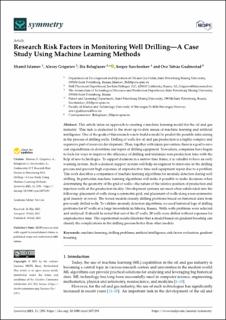| dc.contributor.author | Islamov, S | |
| dc.contributor.author | Grigoriev, Alexander | |
| dc.contributor.author | Beloglazov, Ilia | |
| dc.contributor.author | Savchenkov, S | |
| dc.contributor.author | Gudmestad, Ove Tobias | |
| dc.date.accessioned | 2023-02-22T11:38:24Z | |
| dc.date.available | 2023-02-22T11:38:24Z | |
| dc.date.created | 2021-07-20T12:03:41Z | |
| dc.date.issued | 2021 | |
| dc.identifier.citation | Islamov, S., Grigoriev, A., Beloglazov, I., Savchenkov, S., & Gudmestad, O. T. (2021). Research risk factors in monitoring well drilling—A case study using machine learning methods. Symmetry, 13(7), 1293. | en_US |
| dc.identifier.issn | 2073-8994 | |
| dc.identifier.uri | https://hdl.handle.net/11250/3053207 | |
| dc.description.abstract | This article takes an approach to creating a machine learning model for the oil and gas industry. This task is dedicated to the most up-to-date issues of machine learning and artificial intelligence. One of the goals of this research was to build a model to predict the possible risks arising in the process of drilling wells. Drilling of wells for oil and gas production is a highly complex and expensive part of reservoir development. Thus, together with injury prevention, there is a goal to save cost expenditures on downtime and repair of drilling equipment. Nowadays, companies have begun to look for ways to improve the efficiency of drilling and minimize non-production time with the help of new technologies. To support decisions in a narrow time frame, it is valuable to have an early warning system. Such a decision support system will help an engineer to intervene in the drilling process and prevent high expenses of unproductive time and equipment repair due to a problem. This work describes a comparison of machine learning algorithms for anomaly detection during well drilling. In particular, machine learning algorithms will make it possible to make decisions when determining the geometry of the grid of wells—the nature of the relative position of production and injection wells at the production facility. Development systems are most often subdivided into the following: placement of wells along a symmetric grid, and placement of wells along a non-symmetric grid (mainly in rows). The tested models classify drilling problems based on historical data from previously drilled wells. To validate anomaly detection algorithms, we used historical logs of drilling problems for 67 wells at a large brownfield in Siberia, Russia. Wells with problems were selected and analyzed. It should be noted that out of the 67 wells, 20 wells were drilled without expenses for unproductive time. The experiential results illustrate that a model based on gradient boosting can classify the complications in the drilling process better than other models. | en_US |
| dc.language.iso | eng | en_US |
| dc.publisher | MDPI | en_US |
| dc.rights | Navngivelse 4.0 Internasjonal | * |
| dc.rights.uri | http://creativecommons.org/licenses/by/4.0/deed.no | * |
| dc.title | Research Risk Factors in Monitoring Well Drilling—A Case Study Using Machine Learning Methods | en_US |
| dc.type | Peer reviewed | en_US |
| dc.type | Journal article | en_US |
| dc.description.version | publishedVersion | en_US |
| dc.rights.holder | The authors | en_US |
| dc.subject.nsi | VDP::Teknologi: 500 | en_US |
| dc.source.pagenumber | 19 | en_US |
| dc.source.volume | 13 | en_US |
| dc.source.journal | Symmetry | en_US |
| dc.source.issue | 1293 | en_US |
| dc.identifier.doi | 10.3390/sym13071293 | |
| dc.identifier.cristin | 1922225 | |
| cristin.ispublished | true | |
| cristin.fulltext | original | |
| cristin.qualitycode | 1 | |

